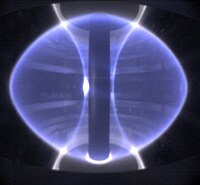
Photo from wikipedia
We consider the design of magnetic mirrors that consist of a layer of two-dimensional high-refractive-index dielectric particles. The central idea is to search for conditions for which the electric field… Click to show full abstract
We consider the design of magnetic mirrors that consist of a layer of two-dimensional high-refractive-index dielectric particles. The central idea is to search for conditions for which the electric field of the light backscattered by a single particle has a zero phase difference with respect to the incident field. Employing physical arguments, we conclude that this can occur when the electric dipolar contribution vanishes. Optimizing the form of the cross section, we find a situation in which the vanishing of the dipolar contribution coincides with an in-phase condition for the magnetic dipole and the electric quadrupole contributions. The resulting scattering pattern of the particle resembles that of an electric dipole, with the difference that the forward and backscattered electric fields have opposite signs. Based on these results, we design a metasurface reflector that behaves as a magnetic mirror at a specific wavelength within a wideband spectral response. Subsequently, we extend the results to the design of supported structures where a magnetic mirror condition at a single wavelength is similarly found.We consider the design of magnetic mirrors that consist of a layer of two-dimensional high-refractive-index dielectric particles. The central idea is to search for conditions for which the electric field of the light backscattered by a single particle has a zero phase difference with respect to the incident field. Employing physical arguments, we conclude that this can occur when the electric dipolar contribution vanishes. Optimizing the form of the cross section, we find a situation in which the vanishing of the dipolar contribution coincides with an in-phase condition for the magnetic dipole and the electric quadrupole contributions. The resulting scattering pattern of the particle resembles that of an electric dipole, with the difference that the forward and backscattered electric fields have opposite signs. Based on these results, we design a metasurface reflector that behaves as a magnetic mirror at a specific wavelength within a wideband spectral response. Subsequently, we extend the results to the ...
Journal Title: Journal of Applied Physics
Year Published: 2019
Link to full text (if available)
Share on Social Media: Sign Up to like & get
recommendations!